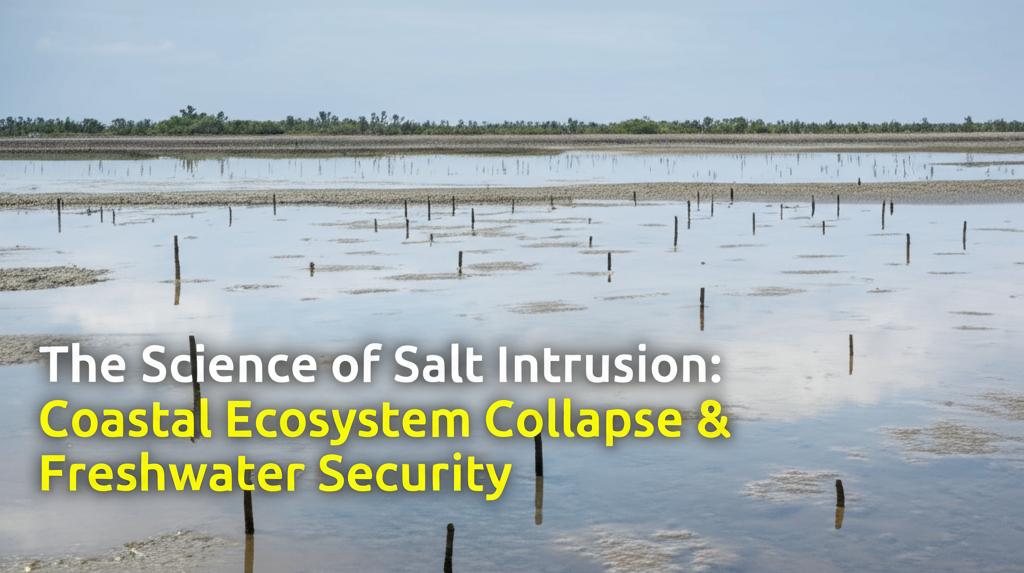A delicate balance is tipping beneath our coastlines, and the consequences are rippling outwards, threatening precious ecosystems and our vital freshwater reserves. The phenomenon is saltwater intrusion, a stealthy creep of seawater into fresh groundwater systems, and it's a growing global concern with profound implications.
At its heart, saltwater intrusion is a story of pressures. Coastal aquifers, underground layers of rock and soil that hold freshwater, naturally meet the denser saltwater of the ocean. Typically, the outflow of freshwater towards the sea keeps the saltwater at bay. However, this equilibrium is increasingly disturbed. Key drivers include the over-extraction of groundwater to quench the thirst of expanding populations and agriculture. As we pump out freshwater, we essentially roll out the welcome mat for seawater to advance inland and even upwards into the soil.
Climate change is a powerful accomplice in this unfolding crisis. Rising sea levels, a direct consequence of melting ice and thermal expansion of ocean water, exert greater pressure, pushing saltwater further into coastal lands. Simultaneously, altered weather patterns, leading to reduced rainfall and subsequent slower groundwater recharge in many areas, weaken the opposing force of freshwater. Studies now project that by 2100, roughly three out of every four coastal areas worldwide could see seawater infiltrating their underground freshwater supplies.
The ecological fallout is dire. Coastal ecosystems, such as mangroves, tidal marshes, and seagrass beds, are exquisitely adapted to specific salinity levels. As saltwater encroaches, these habitats face collapse. Freshwater-dependent plants die off, soil composition changes, and the delicate food webs that support a rich diversity of life are disrupted. Microorganisms, plankton, and corals are among the most vulnerable, and their decline can trigger a cascade of losses throughout the ecosystem. This isn't just an environmental loss; these ecosystems provide crucial services, including storm surge protection and nurseries for commercially important fish species.
For humanity, the primary threat is to freshwater security. Coastal aquifers are a critical source of drinking water for millions and for irrigating agricultural lands that feed even more. Salinization renders this water unusable, leading to water scarcity, declining crop yields, and direct threats to food security and local economies. The slow, creeping nature of saltwater intrusion can make it seem less urgent than sudden disasters, but its long-term impact on livelihoods and public health is immense.
The science is clear: saltwater intrusion is not a distant threat but a present and escalating danger. The interplay of groundwater pumping, sea-level rise, and changing rainfall patterns creates a complex challenge. Recent research highlights that while sea level rise contributes to the widespread nature of intrusion, changes in groundwater recharge rates often determine the severity of how far inland saltwater can penetrate. Some regions, like the U.S. Eastern Seaboard, Southeast Asia, and various river deltas worldwide (such as the Mekong and Bengal Deltas), are identified as hotspots already experiencing significant impacts.
However, knowledge is empowering action. Scientists are improving models to predict and understand saltwater intrusion with greater accuracy. This understanding is crucial for developing effective adaptation and mitigation strategies. Solutions range from restoring natural defenses like wetlands and mangroves, which can act as buffers, to implementing more sustainable water management practices. This includes reducing groundwater extraction, promoting water recycling and reuse, and exploring innovative techniques like managed aquifer recharge (intentionally replenishing aquifers with freshwater). In some heavily affected areas, desalination technologies like reverse osmosis are being employed to secure freshwater, though these can be energy-intensive and costly. Farmers are also exploring adaptation strategies, such as cultivating salt-tolerant crops and improving soil management to flush salts.
The challenge is significant and requires a multi-faceted approach involving collaboration between scientists, policymakers, and local communities. Addressing the root causes, primarily climate change and unsustainable water use, is paramount for long-term solutions. As our coastlines continue to face the dual pressures of human activity and a changing climate, understanding and combating saltwater intrusion is not just an environmental imperative, but a crucial step in safeguarding our future.

